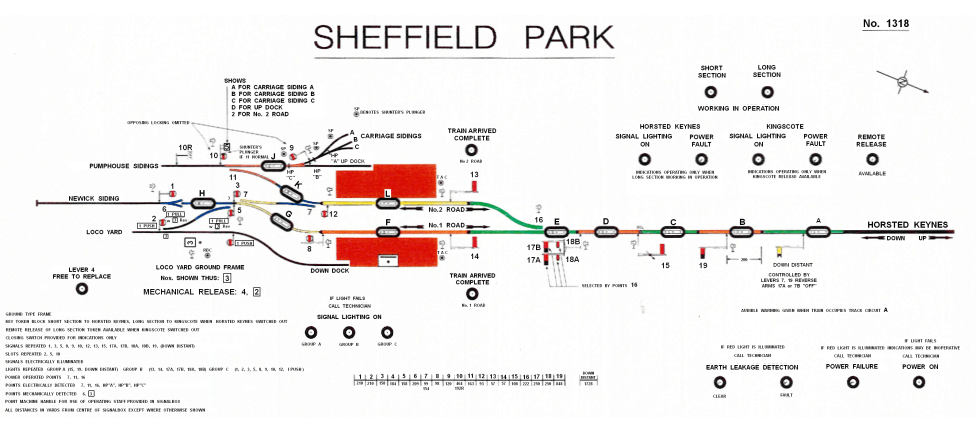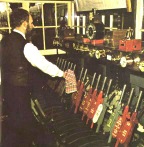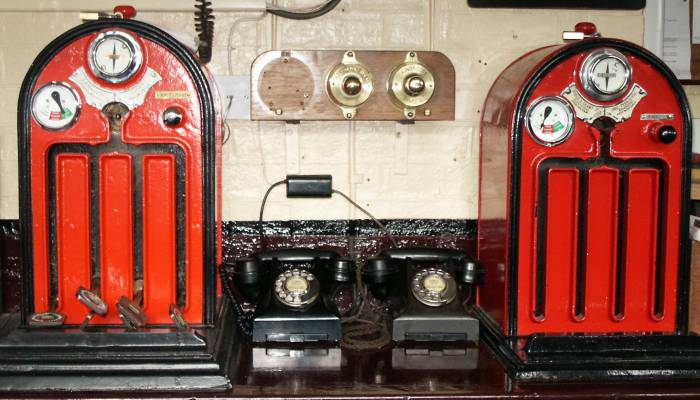Sheffield Park only has trains arriving from one direction but has a lot
happening in the other! When a train is advised to the signalman at Sheffield Park by his colleague
at Horsted as being "in section" then, assuming the road is clear, he will set the route for the
appropriate platform and pull off his signals. We will assume no other movement nor shunting is
happening and that the road is clear to the south end of the platforms. First the signalman will
pull off the outer home signal, 19, then the inner home, 17, which, once both are fully off, will
cause the distant signal to come off automatically, provided the train has not already passed
it.
 Right:
Sheffield Park Inner Home Bracket Signal (17 and 18)
Right:
Sheffield Park Inner Home Bracket Signal (17 and 18)
Photo: Hiroshi Naito
Why, you may wonder, is there just one lever 17 to operate two arms, and how
does the correct arm come off? With only 19 levers in the frame it is obviously useful if some can
perform more than one function so these signals, which are motor driven (as are points 7, 11 and 16),
work according to the road set by the points 16. So, if the road is set for number one platform,
then the left hand arm will drop and if for number two platform, the right hand. Likewise the shunt
signals 18, the "calling-on" arms, also work according to the road set by the point but
unlike the arms above them (17) are not motorised. If the train is a long one, say six coaches
behind a tender engine, then the signalman will also pull off the shunt signal 8 or 12 at the
south end of the station thereby enabling the engine to come to a halt beyond the end of the
platform so that, when the engine has run round and is back on its train, it clears track circuit
"E" as, were this track circuit to be occupied, the platform starter could not be pulled
off.
The first he will know of the forthcoming arrival of the train is when it
arrives on his track circuit "A", some 2,050 yards distant, causing a bell to ring in the
signal box. He can then watch the progress of the train on the box diagram as it illuminates his
track circuit indicators on the final stages of its journey. When the train is in the proximity of
Ketches Halt he will advise the station staff by ringing the platform bell, once for platform one
or twice for platform two. As the train proceeds through the track circuits first the distant, then
the outer home and finally the inner home signal arms will all go back automatically but the
signalman still has to replace his levers for the two home signals. As the train runs into the
station the signalman will go outside to collect the single line token
but will not replace it in the instrument nor give "out of section" to Horsted until he
has been advised by the station staff that the train is complete by means of the Train Arrived
Complete plungers at the north end of each platform. If no station staff are available, then the
signalman himself must check to see the train is complete.
 Left: The interior of Sheffield Park Signal Box
Left: The interior of Sheffield Park Signal Box
Photo: Hiroshi Naito
Once the train is in the station the engine will need to detach, run onto the
Newick siding, then back through the opposite platform road and then on to the other end of its
train. Apart from the shunt signals 8 and 12, no other levers can be pulled until the signalman has
replaced his number 17 lever. Once he has done this he can pull numbers 6 and 5 to gain entry to
the siding. He can also change the point 16 at the north end of the station so that, as soon as the
engine has completed the first move, he can change point 7 and pull off signals number 3 and the
appropriate platform starter for the engine to proceed through the station (often stopping for
water as it does so). Once it is clear of track circuit "H", point 6 and shunt signal 3
can be returned to normal; once clear of track circuit "G" (and "K" if running
through Nº2 road), point 7 can be re-set and when finally the engine is clear of track circuit
"E", the platform starter can be replaced, number 16 point can be changed and number 18
signal, a "calling on" arm, can be pulled off to allow entry to the occupied platform
road.
If no other movement is due from Horsted Keynes then whilst all this has been happening the
signalman will have requested permission to send the train back there and, once this has been given
and the engine is back on its train, he can pull off the platform starter, the advanced starter
(number 15) and go outside to give the single line token to the driver.
 Right: Maker's Plate on Sheffield Park Signal Box
Right: Maker's Plate on Sheffield Park Signal Box
As mentioned above, there is a lot that happens to the south of the station but
not all of it is under the control of the signalbox. Access to and from the Carriage Shed, Newick and Pump House
sidings is controlled by the signalman but all the movements in the carriage shed, loco yard and the dock siding
are controlled locally. Entry to and from this area is controlled from a ground frame which, in
turn, is locked or unlocked by the signalman so that no movements may be set up to or from the
platform area without his permission. In addition, the shunt signals controlling such movements are
"slotted" which means that both the signalbox lever and the ground frame lever must be
pulled before the signal can be off.
In the event of some shunting, or some other such event, temporarily blocking
the station roads when a train is approaching then rule 39a has to be used. This states that
"When a stop signal is at Danger the stop signal next in rear of it and worked from the same
'box must not be lowered (or raised!) for an approaching train until it is close to such signal
and has been brought quite or nearly to a stand." The stop signal in this case being the inner
home, 17, the signalman will wait for the train to arrive at the outer home, 19, (he knows when
because track circuit "B" will illuminate when the train is 200 yards from the signal)
before pulling off the signal. The driver will be warned by this action that he may well have to
stop on the inner home and will approach it accordingly. Obviously, if the movement blocking the
station requires to move north from number one or two road before the station can be cleared, then
the train will have to be held at the outer home until the movement is complete. If the approaching
movement is for some reason to enter an occupied platform road then rule 39a will be applied and as
well as bringing the train almost to a halt at the outer home the signalman will not pull off his
calling-on arm (to enter occupied platform road) until he can see the train is almost on the
signal.
Two token machines are provided, one for the section to Horsted Keynes and one
long section to Kingscote so that trains may run the length of the railway without a Signalman
being needed at Horsted Keynes (typically during low season periods or during evening operation of
the Railway). For this to happen the Horsted Keynes Signalbox needs to be switched out of the
circuit with the points and signals set for a bi-directional route through the Nº3 road at the
station. This, of course, means the single line section is now between Sheffield Park Up Advanced
Starting Signal and the Kingscote Down Advanced Starting signal. Block Bell and 'box to 'box
telephone communication is then established between Sheffield Park and Kingscote once Horsted Keynes
has been switched out. Once long section has been established the Sheffield Park Signal Lighting Switch
additionally controls signal lighting at Horsted Keynes, and at Kingscote when Kingscote is Switched
Out.
Inside his box the signalman has a plethora of information! As well as all the
running lines and entry to the sidings and loco yard being fully track circuited, there are
repeater instruments for the points 7, 11 and 16, for the signals 1, 3, 5, 8, 9, 10, 12, 13, 15,
(17A, 17B, 18A, 18B), 19 and the down
distant and for the slots 2 and 5. All the signal lights are electrically illuminated, and these
are repeated in the box in the case of a failure. There is an indicator to show when Horsted Keynes
'box is closed out which will allow a token to be withdrawn remotely at Sheffield Park for
Horsted Keynes, or for the long section all the way to Kingscote, provided that 'box is manned.
There is also provision for an indicator to show when Kingscote box is closed out, which will only
show when both Horsted Keynes and Kingscote boxes are closed out. There is an indicator to tell the
signalman when the ground frame lever, number 4, can be replaced and two illuminated indicators and
an audible indication for when the Train Arrived Complete plungers are used. There are also audible
and lamp indicators to advise if any signal lamp has failed whilst the lighting is switched on.
Communications provided are telephones at signals 1, 3/5, 8, 9, 10, 12, 13, 14, 15, 17/18 and 19
and at the ground frame and a Walkers Train Describer for the ground
frame operator to advise the signal box which move is required.










 Right:
Sheffield Park Inner Home Bracket Signal (17 and 18)
Right:
Sheffield Park Inner Home Bracket Signal (17 and 18)
 Left: The interior of Sheffield Park Signal Box
Left: The interior of Sheffield Park Signal Box
 Right: Maker's Plate on Sheffield Park Signal Box
Right: Maker's Plate on Sheffield Park Signal Box


